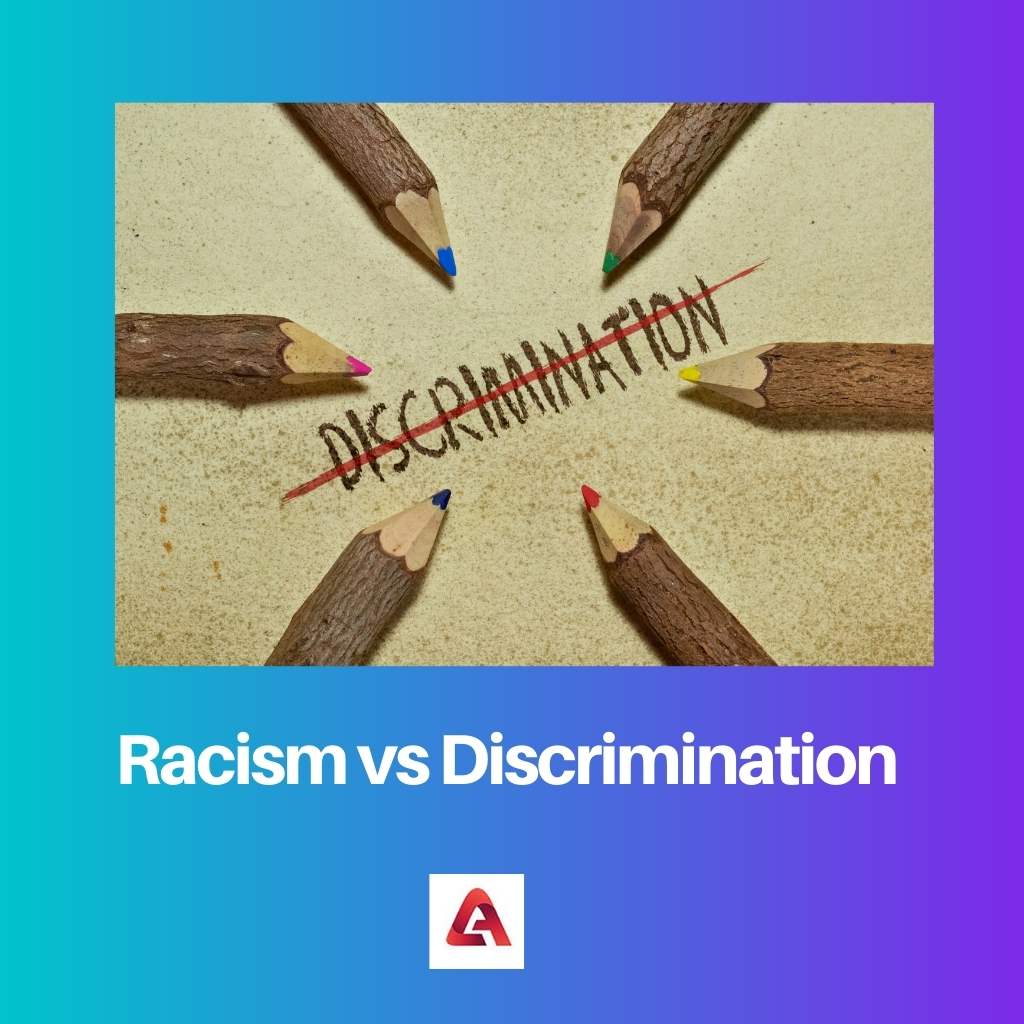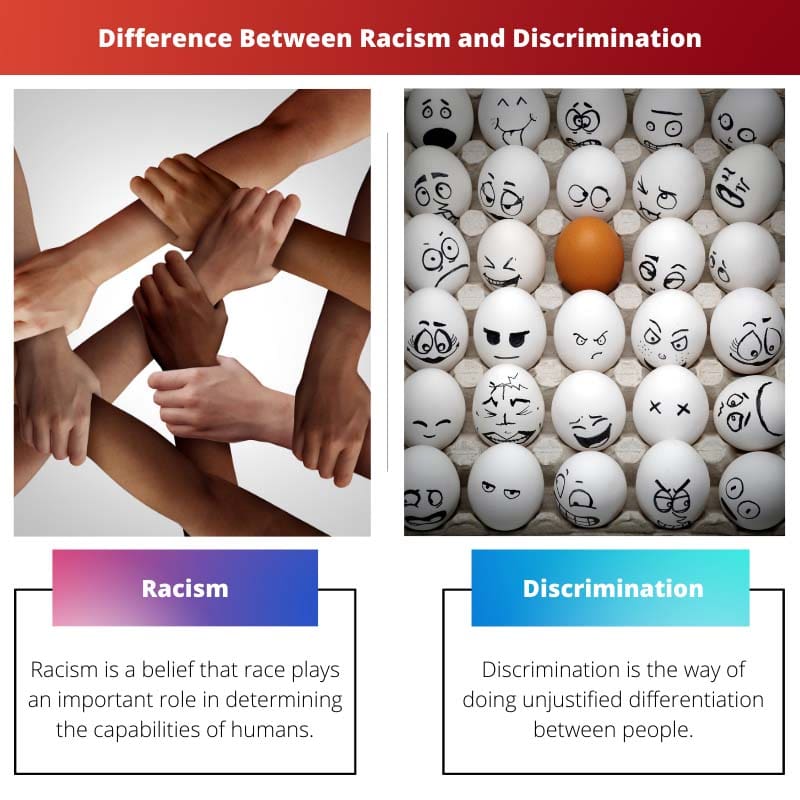When human civilization came into existence, all were living together. There was peace and harmony among the society. All were interdependent with almost any animosity.
Later, humans started to develop, and it was bound to have some negative impact on society. Due to mental construct, it led to the development of the feeling of superiority and inferiority.
Later, it has created differences among the people. Discrimination and Racism are two such tools for creating differences in society.
Key Takeaways
- Racism is the belief that one race is superior to another, while discrimination is mistreating someone based on race, gender, religion, etc.
- Racism is a form of prejudice, while discrimination is a form of unfair treatment.
- Racism can lead to discrimination, but discrimination can also occur without racism.
Racism vs Discrimination
Racism refers to the prejudice to members of certain races, which results in the belief that one racial group is more superior than the other. It is a negative belief and treatment of a racial category that can lead to violence. Discrimination is the biased treatment of people on the basis of ethnicity, race, sex, disability or age.

Racism is a belief that race plays an important role in determining the capabilities of humans. This belief was started in the 17th century when European expansion began.
An ideology of racial supremacy began in America, and white people considered themselves superior to black people.
It is a way of discrimination that led to the exclusion of certain races to access their rights. Which eventually led to disharmony and violence in the society.
Discrimination is related to prejudice. Like considering someone is different from others.
It is the unjustified or prejudiced differences between people based on groups, class, caste, or other categories. But it doesn’t mean that every time, it has negative connotations.
It can happen in many forms, like in many companies; the higher posts are not available for women.
Comparison Table
| Parameters of Comparison | Racism | Discrimination |
|---|---|---|
| Definition | Racism is a belief that race plays an important role in determining the capabilities of humans. | Discrimination is the way of doing unjustified differentiation between people. |
| Based on | It is based on phenotype. | It is based on prejudice. |
| Beginning | It is started with the expansion of the European empire. | It is as old as human civilisation. |
| Types | It may be overtly or covertly. | It may be positive or negative. |
| Nature | It may lead to disturbance in society. Example; Civil war in the USA | It may sometimes lead to development in society. Example; improvement in socio-economic conditions of Dalits and women in India. |
What is Racism?
In the 17th century, with the European expansion to new parts of the world. We see a rise in the ideology of racial discrimination. The concept of Social Darwinism arose on the line of Darwin’s theory.
Racism is a system of differentiation. It loads with both prejudice and discrimination based on social perceptions of observable biological differences between people.
Racism is a belief that race plays an important role in determining the capabilities of humans.
There can be two types of racism in systems of social stratification. One is the Overt, and the second is Covert.
Overt is fed directly into a stratification system through its effect on social status.
For example, members associated with a particular race have a slave status. Covert racism is practised in more contemporary societies.
It is socially hidden and less easily detectable. Variables affecting covert Racism are income, educational opportunities, and housing.
Robert K. Merton and Gunnar Myrdal advocated that every coloured American has been following institutionally prescribed means to pursue culturally specified goals, but they are still facing inequalities.
As per John Rex and Paul Hirst, Race was a product of capitalism, where the slave trade brought down the costs.

What is Discrimination?
Discrimination is the way of doing unjustified differentiation between people based on groups, class, caste, or other categories.
It is a worldwide phenomenon. In almost every country, there is certain discriminatory customs, laws, and so on exist.
But discrimination involves both positive and negative senses. In certain countries, there is a system of reservation or preferences for certain classes.
As they were historically part of social exclusion, so to bring them into the mainstream. The concept of positive discrimination has been brought up by the government and the institutions.
In the case of India, discrimination started during the Vedic period, which is still ongoing. That was the beginning of the caste system and prescribing the caste status like higher caste or lower caste based on birth.
From then to now, the lower caste has been facing discrimination. Along with lower caste, women have also faced discrimination.
So, for their upliftment, the government brought a positive form of discrimination, like providing reservations to them in jobs, education, etc., and started many welfare schemes for their socioeconomic development.

Main Differences Between Racism and Discrimination
- Racism is an art of discrimination, while discrimination is an art of segregation.
- Racism is based on phenotype, while Discrimination is based on gender, caste, sex, and place of birth.
- Racism leads to discrimination, while racism leads to discrimination.
- Racism is an ideology that race plays an important role in determining human abilities, while Discrimination is a way of making unjustified differences in society.
- Racism mainly started in the 17th century, while Discrimination started when human civilisation came into existence.
- Racism creates a disturbance in society, while sometimes Discrimination leads to development in society.


The references provided offer credibility to the arguments presented in the article, making it a well-researched exploration of racism and discrimination.
I couldn’t agree more. The scholarly references augment the analytical depth of the article, enhancing its informative value.
This article is scholarly in its approach, and the comparison between positive and negative discrimination offers valuable insights into the complexities of social inequalities.
Absolutely. The focus on positive and negative forms of discrimination enhances the understanding of social dynamics and injustices.
The comparison between overt and covert racism is particularly interesting. It reveals the complexity and depth of the issue.
Indeed, the article offers a comprehensive analysis of various aspects related to racism and discrimination.
I found the historical context and the explanations about covert racism very enlightening.
This article provides a comprehensive and thoughtful perspective on racism and discrimination, identifying their differences and their origins.
Agreed. It’s a very insightful piece that sheds light on historical and contemporary aspects of racism.
Absolutely. I think it is essential to define these concepts to understand their implications in society.
The information provided about the types of racism and discrimination, and their impact on society is thought-provoking and well-reasoned.
Agreed. It’s an enlightening read that invites critical thinking about the dynamics of social inequalities.
The article effectively highlights the relationship between racism and discrimination, offering valuable insights.
A thought-provoking and enlightening piece that provides valuable insights into the historical and contemporary dimensions of racism and discrimination.
The inclusion of examples and historical context makes this article a compelling resource for understanding the complexities of racism and discrimination.
I appreciate the depth of analysis and the nuanced approach to examining the origins and implications of racism and discrimination.
Absolutely. The historical perspective provides a strong foundation for comprehending contemporary issues related to racism and discrimination.
The comparison table is particularly helpful in clarifying the distinctions between racism and discrimination, contributing to a well-structured and informative article.
I appreciate the clarity and accuracy of the comparison table, as it succinctly captures the key differentiators between racism and discrimination.
Absolutely. The layout and organization of content, including the comparison table, enhance the article’s accessibility and coherence.